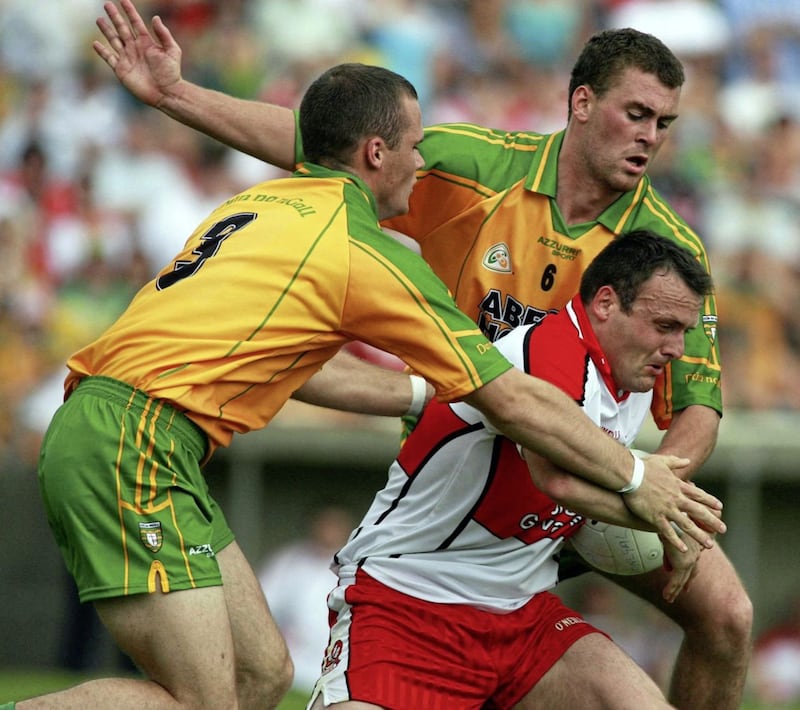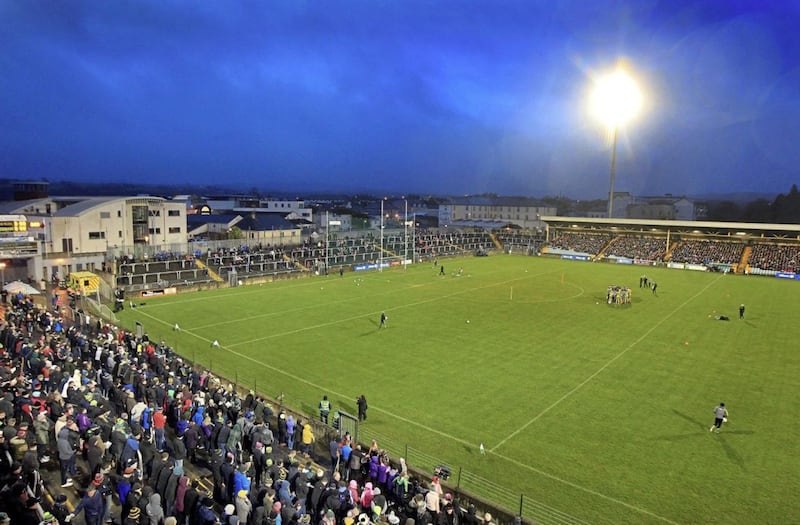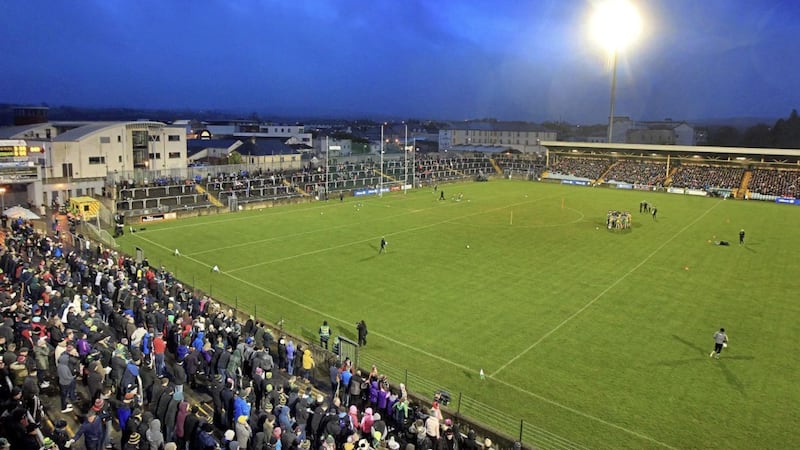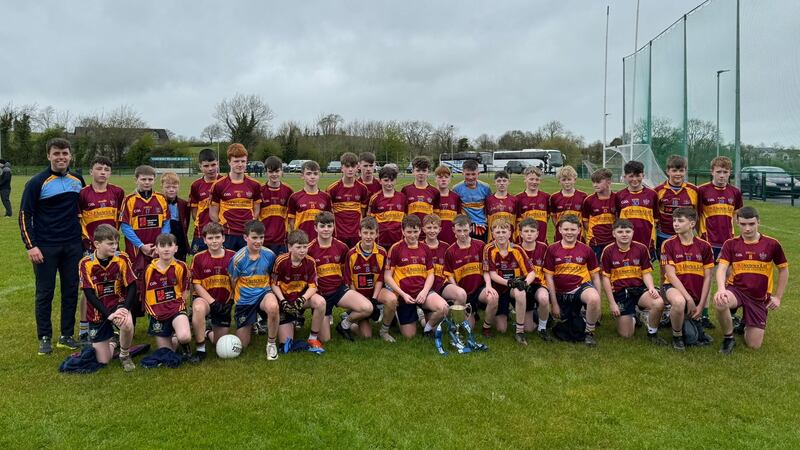“There was an imaginary ghost on the training field when we were doing runs, a man in a Tyrone jersey running beside you, pushing you on. It was always there. Most nights they were mentioned.”
Eamon McGee
****
SLIGO were half gone out the gate, leading 1-11 to 0-6 with Donegal down to 14 men.
Jim McGuinness had his doubters and the first 46 minutes of his reign didn’t do much to shoo them. They were bound for a most inauspicious start in MacCumhaill Park.
But as it’s been, they found a way not to lose. Michael Murphy rebound off a saved penalty, then Neil McGee – of all men – draw two redemptive green flags. 2-11 to 1-14. A draw. A starting point.
They haven’t always won in Ballybofey since then, but they’ve never lost. This will be game number 20 in league and championship since their last defeat at the ground, inflicted by Down in the summer of 2010.
Donegal have lost a smaller percentage of their home games in Ballybofey over the last decade than Dublin have in Croke Park.
And they’ve all been there. Dublin twice, Mayo twice, Kerry, a Cork side not long off their All-Ireland in 2012. None more than Tyrone, though.
Sunday will be their sixth visit for a league or championship game since their last win there in 2005, when Colm McCullagh snatched it with a late goal.
That Tyrone’s wait for a summer win in the venue goes all the way back to 1973 is a true statistic wrapped up in a lie, given that none of their nine meetings between the following’s year clash and the 2013 edition actually took place there.
But they know well its aura.
Joe McMahon knew of it from he was a boy. His father Paddy, an uncanny photo of whom did the rounds this week, played in those games in the 70s. They were fierce heavy days, with bottles and cans being flung on to the pitch at injured players during the ’73 game.
Joe wasn’t a regular to Ballybofey as a player – he was a sub in 2005, and didn’t play at all when they met again four years later or in 2015.
2013 was different. Donegal had put their stamp on their Ulster meeting in 2011 – a bruising affair in which McMahon suffered a broken jaw after a tackle from Leo McLoone – and 2012, when the Tír Chonaill men had gone on to win Sam Maguire.
They weren’t shy of reminding Tyrone of that fact on the soggiest of late May afternoons. The game mirrored the claustrophobia of the build-up.
“When we arrived down there, it was a small, poky changing room with very little room to manoeuvre – certainly with the size of squads that are about these days,” says McMahon.
“We came, got ourselves togged out and went out to the warm-up area and you just sense the atmosphere, the whole backdrop to it.
“It was a time when Donegal had begun to dominate Ulster. I remember coming down the road on the bus journey and there were a couple of people along the road with just this loose door, hinting that we’d be heading the back door route.
“Also somebody had a Sam Maguire en route on the street, a gentle reminder of who the All-Ireland champions were. A wee mental thing to say ‘this is what’s going to happen today, you’re not going to come down here and defeat the All-Ireland champions’.
“The whole thing was set for what happened. The day itself, it wasn’t a great day. I got sent off that day for two yellows, probably the frustration of the whole day just got the better of me.”
To their detriment, though, the game had subconsciously become Donegal’s whole year.
Ever from that first meeting in the Downings back on Novembers 6, 2010, McGuinness had hammered the hammer. Tyrone. Tyrone. Tyrone.
It was all that Donegal heard and saw in those first couple of years, before their eyes could afford to look beyond.
“It was always Tyrone,” recalls Eamon McGee.
“Jim looked at Tyrone and said this was where we needed to get to. Their team of the noughties, this was where we needed to get to.
“And we always felt Tyrone looked down their noses at us, but the funny thing was that we weren’t even on Tyrone’s radar. That’s how far down the scale we were. We were nowhere near.
“We got that impression that Tyrone and Armagh both looked down on us.
“When Jim took over, he said this was the team we needed to beat to become the top team in Ulster. Everything was about Tyrone. Whatever they’re doing over the border, we need to train harder.”
There was no escaping that sense for McMahon or the rest of the Red Hand players.
“I always remember McGuinness’ book and all their focus was on Tyrone when he came in,” he said.
“They were the team, and they felt they almost had to mirror themselves on Tyrone to beat Tyrone, only with a bit more aggression and belief.
“That’s something he instilled in those boys and that’s what he got out of them.
“Going into that game in Clones [2011], that’s what they set out to do. There were a couple of occasions in the match, a couple of turning points.
“Those moments, people say it’s a bit of luck, but there’s the famous saying about when luck meets opportunity.
“That was a huge thing for them and it gave them belief to say ‘Jesus, Tyrone aren’t that hard beat’ and they kicked on from there.
“I don’t think they’ve looked back since. It’s right into minor, u20s, right into seniors and I think Tyrone need to gain a bit more belief themselves going down there this weekend.”

****
SAM Maguire had barely found its snug in the hills when the sides were paired again for the 2013 Ulster quarter-final.
As the celebrations evaporated over time, it morphed into seven months of preparation, and Donegal’s motivation became keeping Tyrone’s heads under water.
“It’s definitely something we talked about in the huddles and groups, that Tyrone have building for this, and we’ve been building for this, and if we can just put them away,” says McGee.
“It might seem over the top, but we had our foot on the throat of Tyrone, we had to keep the foot there and keep the pressure on them.
“Jim talked about it in the group. It was summed up when Stephen O’Neill went for the shoulder challenge with Neil, and Neil put him back on his ass.
“That was an image of Donegal pushing Tyrone aside and moving on. We built that game up so much and worked so hard for it that it was one of the many reasons we fell flat later on in the year.”
Their current unbeaten run is partly a reflection of the quality of players they’ve produced since 2010, but it’s also founded on the long-standing tradition that MacCumhaill Park has never been an easy place to go.
Paddy Campbell was a son of the noughties, a mixed time for Donegal football, when Ulster finals were a regular occurrence without them ever carrying the cut of a winning team.
Yet the Glenties man was rarely a loser in Ballybofey either. The feeling that they are a different side there from on any other pitch has long been part of the Donegal psyche.
“I’m not sure how often I ever lost in MacCumhaill Park as a Donegal footballer – it was a very rare occasion. I’d need to think very hard to find a game that I did lose in it.
“For some reason, the players love it. It’s suited to us. It sets a different tone to the game.
“It’s not a great pitch, there’s contours on it and it’s up and down, but whatever’s about it, the players love it.
“If Donegal were playing in Letterkenny against Tyrone, I’d say that most of the players would doubt the result of the game. They’re not doubting the result when it’s in Ballybofey.”

****
THE old tunnel. The walls with the plaster chipped everywhere. The concrete steps that look wet even when they're dry.
There are few places that look more uninviting.
It's where Donegal feel most at home, and yet they play only a fraction of their games there.
The rotation of National League games between Ballybofey, Letterkenny and Ballyshannon means that they’ve had to pick and choose their conquests on the brow of the Finn.
The vast majority of their training sessions - especially when the ground hardens - take place in MacCumhaill Park, but they don't get to play games there as often as they'd like.
“As players, you can be oblivious to the politics of it and trying to promote the game,” says Eamon McGee.
“But definitely, I’ve been involved in conversations as a player, with management and county board officials, to say: ‘Listen, why can we not have all the games in Ballybofey?’
“In fairness to the county board, they need to take a game to the south and take one to O’Donnell Park. They’ve worked hard to get the pitch up to standard and they need to be rewarded.
“But as players, we’d definitely have talked about it, that all our games should be played in Ballybofey.
“It, to us, was always our home. If truth be told, none of the players wanted to play outside Ballybofey. We’d always rather have played there because we’re comfortable there.
“That’s where it stemmed from, the fact that we know it so well. We know every bounce, every bump. We trained hard there, we’ve good memories there.
“It’s something that just gained momentum. You didn’t really think much about it when you’re playing but it is powerful, and the longer it goes on, the more powerful it becomes.
“It’s a massive advantage to Donegal. People have asked me if we set out to make Ballybofey a fortress. It was never mentioned, but you just knew going in there, your home ground, you do whatever you have to do to win.
“The longer it goes on, you take pride in something and start to think you’re not going to be beaten there. It definitely gives you a psychological boost that teams are talking about it.
“It doesn’t matter what anybody says, there are very few players that aren’t going to pick up a paper and read that Donegal aren’t beaten here since 2010.”
Tyrone felt the benefit of their own home comforts two weeks ago when they hemmed Dublin in between the tighter confines of Healy Park, making for a much better fist of it than in last year’s Croke Park semi-final.
The Jones’ Road venue was felt rather soulless in the opening round of games in these new-fangled Super 8s. Ballybofey will be anything but soulless.
“It’s one of those pitches where the crowd’s on top of you,” says Omagh native McMahon.
“I know you’ve huge numbers in Croke Park but in Ballybofey, it’s as if they’re right there beside you. With the rivalry that’s been built up in recent years, it was just really, really hostile at times.
“As a player, you don’t tend to take that on as much as the supporters do at times. They’re caught up in the emotion of it but as a player, you can’t afford to do that because as soon as you do that and let the emotions get the better of you, that’s taking your mind off the game.
“There were times that you might have heard supporters expressing their emotions towards us, in one way or another.
“The whole emotion and everything about it, we felt we could pull a scalp, but it wasn’t to be. They’ve never really looked back in terms of their Ballybofey performances.”
It was always about Tyrone. Still is.
****
Donegal’s record in Ballybofey 2009-2018
Played 28
Won 21 (75%)
Drawn 5 (18%)
Lost 2 (7%)
Dublin’s record in Croke Park 2009-2018
Played 95
Won 78 (82%)
Drawn 6 (6%)
Lost 11 (12%)
Tyrone's record in Healy Park 2009-2018
Played 42
Won 23 (54%)
Drawn 4 (10%)
Lost 15 (36%)







